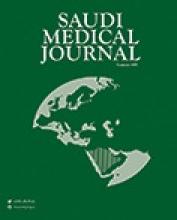Abstract
OBJECTIVE: Pilonidal sinus is a disabling nuisance in young adults, yet its management remains controversial.
METHODS: Patients admitted to Prince Abdulrahman Sudery Hospital, Al Jouf, Kingdom of Saudi Arabia, over a period of 10-years from January 1990 to December 1999 were evaluated in this retrospective study. We compared 2 most commonly performed surgical operations in 272 patients consisting of group A, 176 patients, managed by excision and primary closure and group B, 96 patients, managed by excision and healing by the second intention.
RESULTS: More than 90% of group A achieved primary healing within 10 days. Although 100% of group B achieved eventual healing, it took a significantly longer period, mean 48 days (p<0.0001). Failure of primary healing occurred in 16 (9.1%) group A patients but 6 (3.4%) of these were amenable to secondary closure and still achieved healing in a shorter period of time than group B (p<0.05). There was no significant difference in the recurrence in the 2 groups.
CONCLUSION: We conclude that although hospital stay and consumption of inpatient hospital resources was greater for group A, excision and primary closure is a superior option for most patients and especially for patients who are largely young and active.
- Copyright: © Saudi Medical Journal
This is an open-access article distributed under the terms of the Creative Commons Attribution-Noncommercial-Share Alike 3.0 Unported, which permits unrestricted use, distribution, and reproduction in any medium, provided the original work is properly cited.






